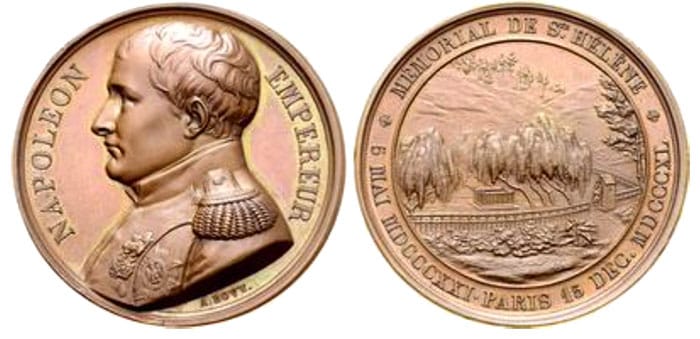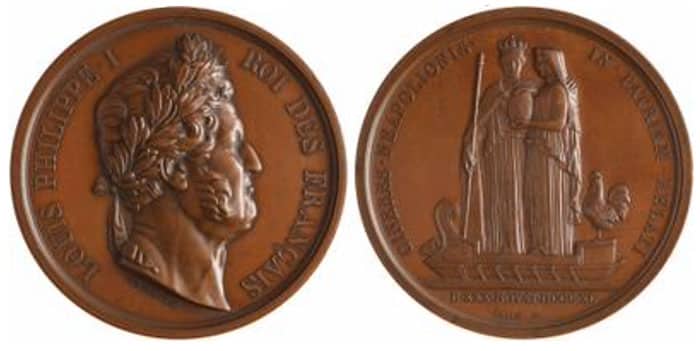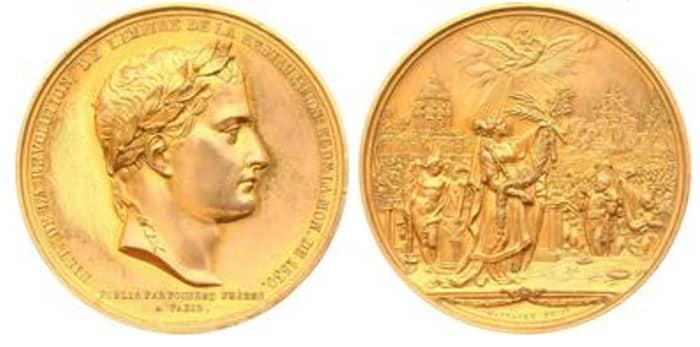By Tyler Rossi for CoinWeek …..
“It is my wish that my ashes may repose on the banks of the Seine, in the midst of the French people, whom I have loved so well.”
Such was the first request made in the Last Will and Testament of Napoleon Bonaparte, Emperor of the French, King of Italy, Protector of the Confederation of the Rhine, and a broken man. For one who strode across the continent defeating enemies and overthrowing regimes, Napoleon died an ignominious death on the island of St. Helena. Loved and reviled, Napoleon passed away after six years of exile on the tiny island, 7,247 km from his beloved Paris in the Atlantic Ocean off the southwestern coast of Africa.
Contrary to Napoleon’s final wishes, however, Governor Hudson Lowe decreed that his body would be laid to rest on the island. Despite claims to the contrary, the emperor suspected that the British would not follow his request, so he stated “…in the event that orders have been given for my body to remain on the island, which I do not believe is the case, have me buried in the shade of the willows where I used to rest … near the fountain where they go to fetch my water every day.”

This medal was struck in 1840 but uses the dual dates of 1821 and 1840 to commemorate Napoleon’s Tomb at St. Helena and his final return. A handsome specimen, this example displays traces of the original gilding common to this type. Recently, several examples in high grade sold at auction for $150 to $200 USD. It is important to note that while some examples were gilt, most were plain bronze.
Now known as the Valley of the Tomb or Napoleon’s Valley, this clearing remained the emperor’s last resting place until 1840 when King Louis Philippe I petitioned the British government for permission to return the dead emperor to France. As early as October 1830, popular petitions began circulating aimed at returning Napoleon’s remains. On May 12, 1840, a bill was introduced by French Interior Minister Charles de Rémusat to the Chambre des Députés to appropriate one million francs “for translation of the Emperor Napoleon’s mortal remains to the Église des Invalides and for construction of his tomb.” This move tied neatly with Louis Philippe’s mission to reclaim “[a]ll the glories of France” when he opened a museum of history in the palace at Versailles.
The most current theory of Napoleon’s death, posited in 2007 by American, Swiss, and Canadian researchers, is that the former emperor “died of a very advanced case of gastric cancer that stemmed from an ulcer-causing bacterial infection in his stomach”. The researchers also concluded that there was absolutely no chance of Napoleon surviving even if he were on the mainland and received the most cutting-edge medical care. In fact, they claim that “even if treated today, he’d have been dead within a year”.

Immediately after the emperor’s death at 5:49 pm on the sixth of May, 1821, Lowe relinquished formal control of the corpse to Archibald Arnott, Napoleon’s surgeon while on the island. Prayers were recited over the body, which was then subsequently cleaned and dressed. A death mask was made one day later, on the seventh, which is now kept at the Musée de l’Armée in Paris.

Napoleon’s remains were exhumed on October 15, 1840, and to confirm that the body remained and was intact, his coffin opened on the 16th. Carried by La Belle Poule, a first-class frigate with a battery of 60 guns, Napoleon’s remains left St. Helena and arrived at Cherbourg on November 30. Transferred to La Dorade, the coffin steamed up the Seine to Courbevoie, a small village outside of Paris.


This rare medal illustrates La Belle Poule under full sail on its journey to collect Napoleon’s remains. At a 2018 auction, the above example sold for $500. This type also was struck in bronze with the same 41.5mm dimensions and is valued between $150 to $200. Unfounded fears of a British attack, whetted by deteriorating Anglo-French relations in the aftermath of the anti-semitic Damascus Affair, prompted the French to send a heavily armed vessel. These fears proved unfounded as no attempt was made by any British vessel. Later in 1880, a similar medal was struck using a similar very similar reverse die, as can be seen below.

Reserving only the best for the former emperor, the French government commissioned “an enormous funeral carriage drawn by 16 black horses” to process towards the Arc de Triomphe down the Champs-Élysées and to Église des Invalides. After this massive spectacle, Napoleon’s remains rested in the Chapel of Saint-Jérôme at the Église des Invalides until his final resting place in the ornate domed chapel was completed 20 years later in 1861.
Coincidentally, while not stuck as an official series, the next two medals form part of an unofficial series documenting the journey of the imperial remains back to Paris starting when La Belle Poule docked at Cherbourg.

This medal featuring the current king, Louis Philippe, on the obverse was struck to commemorate Napoleon’s arrival in Europe at the port of Cherbourg. Standing in a stylized galley with oars, a female personification of France receives a funerary urn that represents Napoleon’s body. Alongside her are a second hooded figure and the Gallic rooster.

Designed by Alexis Depaulis, the famed French sculptor and medalist, this medal commemorates Napoleon’s body passing through Rouen on its return journey to Paris. When translated to English, the obverse legends read: SAINT HELENE V MAY MDCCCXXI in the upper fields and I WISH MY ASHES TO REST / ON THE BANKS OF THE SEINE, / IN THE MIDDLE OF THIS FRENCH PEOPLE / THAT I HAVE SO LOVED in exergue. The reverse legends read R / SAR THE PRINCE DE JOINVILLE COMMANDING THE EXPEDITION in the upper fields and PASSAGE TO ROUEN / DEATH REMNANTS / EMPEROR NAPOLEON / DECEMBER X MDCCCXL in exergue. This medal comes in both bronze and silver varieties. While the former is valued between $150 and $200, the latter is much rarer and costs slightly over $1,000.

While dated 1830, this medal, engraved by Jean P. Montagny, was struck by the Pourrat brothers in 1840. It depicts a laureate bust of the deceased emperor on the reverse and a very busy tableau on the reverse. The reverse shows the coffin of Napoleon I as it is borne aloft by his followers. In the center, the personification of France hoists laurel and olive branches up to the sky as an angel holds the letter N on an altar.
The medals described in this article are not a comprehensive listing of the “Return of the Ashes” category. The French struck many medals commemorating the final return of Napoleon Bonaparte to Paris, a fitting tribute to an event of great national importance
I have recently discovered the vast world of Napoleonic medals and encourage all numismatists to read up on the subject to learn about this fascinating period.
Happy collecting!
* * *
Sources
https://www.napoleon.org/en/history-of-the-two-empires/articles/napoleons-last-will-and-testament/
https://www.sciencedaily.com/releases/2007/01/070116131630.htm
https://www.napoleonsthelena.com/en/the-emperor-s-tomb/
https://en.chateauversailles.fr/discover/history/key-dates/inauguration-historic-galleries-1837
https://shannonselin.com/2017/05/napoleons-body/
* * *
About the Author
Tyler Rossi is currently a graduate student at Brandeis University’s Heller School of Social Policy and Management and studies Sustainable International Development and Conflict Resolution. Before graduating from American University in Washington D.C., he worked for Save the Children creating and running international development projects. Recently, Tyler returned to the US from living abroad in the Republic of North Macedonia, where he served as a Peace Corps volunteer for three years. Tyler is an avid numismatist and for over a decade has cultivated a deep interest in pre-modern and ancient coinage from around the world. He is a member of the American Numismatic Association (ANA).




